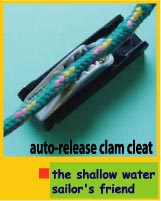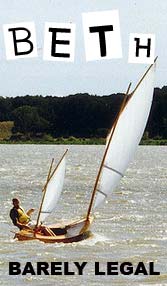New Unique Amateur-built Ship Made of Wood has Crew of 55

The largest amateur-built wooden ship since Noah"s Ark will soon get under way in the U.S. The 62—foot power boat will be built by 55 men who will be crew; owners and builders. (Yes there is a ha1f·scale version of Noah's vessel in the Netherlands, but the builder is a professional not an amateur.)
The military style Foreign Legion Navy ship number 17 is the idea of designer and boat builder Jim Betts, who founded Amateur Boat Building magazine in the 1960s and the new version of the magazine published in 2002. It is no longer published, but Jim thinks the time is right for a major effort by the many amateur builders who want to stop dreaming and start building and traveling.
The vessel has some unique features. The hull is built of common one—inch lumber in three layers like the PT boats of WW 2. It will finish 2 3/4 inches thick and will be almost as strong as the USS Constitution "Old lronsides." The deep-V hull is easy to build as there is very little bending. The "crew" will build the boat in Mississippi at a shipyard with suitable facilities and they will live there for the three months building will take. The 55 men will work in two shifts and some will work on the interior components outside the hull and move them into the completed hull later. (This is the method of sub-assembly used by large cargo ships today.) With no labor cost and many labor-saving techniques, and the use of off-the—shelf materials and equipment and an economical l0—knot speed, the cost will be about $100,000 or one fourth that of a manufactured vessel of this size.
Members of the team must be single, retired men. While boat-building experience is not required, some degree of woodworking skill is a plus. It is anticipated that most of them will live aboard in retirement, but short—term participation will be available. A requirement is that they must have an income of at least $1,000 per month from Social Security, retirement, etc.
Total cost of living aboard — prorated cost to build, food, fuel, even laundry and other services —— will be about $300 per month. Where else can you live and travel at sea for that?
The ship will be based in Aruba, which is out of the hurricane zone and will travel the Caribbean Islands with frequent layovers to enjoy each island's attractions. The ship has a range of 2,000 miles, but bladder tanks may be used to travel to other areas such as the Mediterranean.
 |
 |
The quarters deck has triple-deck bunks like Navy ships, but the main deck has spacious lounge and dining areas as well as a library. There are four deck areas. Other features include a handicapped cabin for four with elevator to other decks, a dive raft and shore launch, VSAT communications system, radar and other safety equipment to SOLAS standards. The wooden construction and compartments with watertight doors, make the ship virtually unsinkable. The twin masts (like a football goal post) and booms support an awning that also catches rainwater to augment the water maker and provide cargo lifting, and they are rigged with steadying sail and flopper—stoppers and trawls for fishing. (The "gun" on the foredeck and the jet engine" on the cabin top are not what they seem, but do provide many services. A plus is that the "gun" should keep pirates away and also help get a favorable anchorage!)
For now, Jim seeks interested people. There is no web site or phone, but for more infomation you may e-mail him at: ForeignLNl7@aol.com. You must send your Post Office mail address and four suggestions for the design and/or the program in general. If you do not send four ideas, suggestions, drawings, or comments your request for the free information will not be processed.
TECHNICAL INFO:
- LOA 62 ft.
- WL length 55 ft.
- Beam at deck 24 ft.
- Beam at WL 22 ft.
- Displacement 34 tons
- Power 380 HP diesel
- Speed 10 knots
SOME EARLY Q & A:
Is there a "real" Naval Architect involved?
Yes. The ship is really a bit over my head and so an established designer will be brought into the picture. Anyway, the insurance company insists on this. And you cannot enter many ports without insurance, so one thing demands another.
What are the real functions of the "gun" and "jet engine?"
The foredeck "gun" houses deck gear for anchor and mooring and — when the barrel is pointed up — supports the forward end of an awning. The 'jet" houses air intakes for HVAC and engine, plus galley, engine, generator and head exhausts. (In my book "The Million Dollar ldea" I say that one ofthe requirements for a good new product is to "put a pith helmet on it." Make it an adventure. So I feel the overall image of the ship does that and the fake Bofors 40-mm cannon sure helps. Plus grey paint and the military—style number on the hull.
What will the crew do?
For the most part - nothing! However, there will be many duties such as cooking, KP, general cleaning, laundry, etc. You may be captain or Officer of the Deck one day and swab jockey the next. The ship will be in port most of the time so there will be much to do ashore. There may be activities such as discussion groups, games, exercise classes and hobbies. Much depends of the desires ofthe crew. With several areas on deck and below, there will be room to be apart.
Why is the crew limited to retired men?
Well, if there is a sociologist who can tell me how to do otherwise, let me know! Note that in keeping with the Foreign Legion "image," you need not give your real name. (Don't ask why!)
Is there a doctor on board?
It is anticipated that we will attract a doctor. At least a good medic. We will always be in port or only a matter of hours from a port, so medical help is not far away. (There is —-— failing all else — free burial at sea.)
Do you have to sign-on for a specified time?
No. You may jump ship at any time. It is anticipated that there will be a waiting list to fill the bunk you leave behind.
How about diets?
Meals will be served cafeteria style and there will be only one choice of entree at most meals. A survey of the crew will determine if there are any serious dietary needs, likes and dislikes and what can be done to conform. (And you can always eat ashore when in port.)
Are there any restrictions?
No smoking, no non—prescription drugs. Alcohol use allowed in moderation. Bad behavior will not be tolerated and anyone may be tossed off for unsatisfactory conduct.
How sanitary are conditions with 55 aboard?
There is sufficient water generation at sea (and shore water in port) for daily showers. Clothing, bed linens and such are laundered with washing machine and air dried when possible. In order to simplify clothing laundry, crew will wear uniforms. Shore clothing will be laundered as needed, Ports require holding tanks and/or shore connection to sewers. Holding tank pumping and direct discharge are allowed when the ship is more than three miles offshore. There is a main head in the quarters area and auxiliary heads in other locations. (Unlike the military, everyone does not get up at the same time, so use of toilets is over a longer period. Yes, yes, retired men of a "certain age" may go more often, but that will work out. At sea, there is always the lee rail. The galley is equipped with commercial grade equipment including high—temperature washing. How about overall safety? The hull has three compartments with watertight bulkheads and doors. Ladders up to the deck are easily reached. The engine compartment has automatic fire extinguisher system and the ship has fire extinguishers and water hoses ready for use. Three 25-man inflatable life rafts are carried on deck and 83 personal life jackets (crew plus 50%) are carried in overhead locations throughout the ship. The shore launch (16-foot Boston Whaler) and dive platform are also suitable for emergency use. All SOLAS (Safety Of Life At Sea) regulations are observed. Portlights are fixed and are of the type used in jet aircraft.
What does Jim Betts get out of this?
I get to be Administrative Officer (and not pull KP or swab the decks) and I ride free. That's all I want in addition to the pleasure of seeing this work!
WHO IS JIM BETTS?
I'm sure most of you do not know who I "used to be." Back in 1963, I founded Amateur Boat Building magazine. We published "how-to" articles and news of new designs and methods of building. This grew to more than 15,000 circulation worldwide. Several years later I turned this over to a group of members and it lasted a few years and folded up. A couple of years ago I tried to relaunch this and published it for a year, but there really is not as much interest as needed. By way of background, I'm an old newspaper reporter and worked for the Associated Press. Later, I was editor of several business magazines and then started Early American Life magazine, which grew to more than 150,000 circulation. This was later sold, but is still published. I then founded Point Publishing Co., publisher of newsletters, books, videotape training films and training aids in the fields of new product development, creative thinking and textiles.
Then too I have been a sailboat racer for about 50 years starting with a Blue-J that I built. I raced on my own L-16 and Irwin 28 five sleeper and crewed on several Etchells 22s, including the one raced by the late, great George O'Day. I was also one of the first people in the U.S. to own and race a Yngling. I took up sailboat racing because it is the only sport you can do sitting down with a sandwich in one hand and a beer in the other. They never told me about the midnight thunderstorms and such! I am author of three books on public relations, creative thinking and new product development and am co-author with Ted Brewer of the book "Understanding Boat Design". Ted and I founded the Yacht Design Institute, a 24-lesson home-study program. (Now part of the Westlawn program.) I also served as a consultant to American Boat & Yacht Council doing work on safety standards and publications.
|








